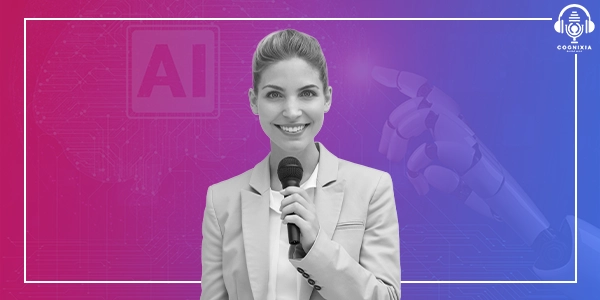Hello everyone, and welcome back to the Cognixia podcast! Today, we are diving deep into something creating massive waves in India’s technological landscape. You know how everyone has been talking about AI lately, right? Well, India’s latest budget just took that conversation to a whole new level, and we are going to break down exactly what this means for you, education, and our nation’s future.
Let us start with a quick flashback. Cast your mind back to 2023, when Finance Minister Nirmala Sitharaman first showed us that AI was not just a buzzword for India but a serious priority. She announced three centers of excellence focusing on agriculture, health, and sustainable cities. Those centers have been doing some incredible work.
But hold onto your seats, because what’s coming in the 2025-26 budget is mind-blowing! The Finance Minister just announced a new center of excellence specifically for AI in education, together totaling the investment in centers of excellence to INR 500 crore. Now, you might be thinking, “Okay, that’s a big number, but what does it actually mean for us?” Well, let us break it down for you.
Imagine walking into a classroom where AI is not just a subject being taught – it is an active participant in the teaching process. This new center of excellence is going to be like the command center for transforming India’s entire education system, from the tiny tots in pre-primary schools all the way up to researchers pushing the boundaries of knowledge. We are talking about personalized learning at a scale that was previously unimaginable.
But here is where it gets really interesting. The government isn’t just throwing money at a trendy technology – this is part of a much bigger picture. Remember the National Education Policy 2020? This new AI initiative fits perfectly with those goals. It is like adding a turbocharger to an already powerful engine. The NEP wanted to revolutionize Indian education, and now AI is going to help make that happen faster and more effectively than anyone imagined.
Let us talk numbers for a minute because they are pretty impressive. The IndiaAI Mission’s budget has been ramped up to Rs 2,000 crore – that’s nearly four times last year’s estimate of Rs 551.75 crore! And if you compare it to the revised estimate of Rs 173 crore, we are looking at more than a tenfold increase. That is not just an increase – that is a statement of intent.
But wait, there is more! The Finance Minister did not stop there. She announced five new national skill development centers that are being set up with global partnerships. Now, this is huge for anyone interested in the ‘Make in India’ initiative. These centers are not just going to be training facilities – they are going to be innovation hubs where global best practices meet Indian talent and creativity.
Here is something that really got us excited – the announcement of 50,000 Atal Tinkering Labs in government schools over the next five years. Now, if you are not familiar with Atal Tinkering Labs, let us paint you a picture. These are not your regular computer labs. They are like miniature innovation centers where kids can let their creativity run wild. They will have access to 3D printers, robotics kits, sensor technology – all the cool stuff that most of us only dreamed about when we were in school.
Think about what this means for a moment. We are not just talking about teaching kids to use technology – we are talking about teaching them to create technology. These labs are designed to foster innovation and entrepreneurial skills from an early age. It is like planting 50,000 seeds of innovation across the country. And you know what happens when you plant that many seeds? Some of them are bound to grow into something extraordinary.
The government is also tackling the digital divide head-on. The BharatNet project is being expanded to provide broadband connectivity to all government secondary schools and primary health centers in rural areas. This is massive! No more will a student’s location determine their access to quality educational resources. Whether you are in Mumbai or a remote village in Madhya Pradesh, you will have access to the same digital resources.
Let us also talk about the Bharatiya Bhasha Pustak Scheme for a minute. This is something that really shows the government’s commitment to inclusive education. They are making digital books available in Indian languages for both school and higher education. Why is this important? Because language should never be a barrier to learning. Now, students can understand complex subjects in their mother tongue, making education more accessible and effective.
The integration of AI into education is not just about fancy technology – it is about solving real problems. Think about the challenges our education system faces – teacher shortages in rural areas, inconsistent quality of education, difficulty in monitoring student progress, and the need for personalized attention. AI can help address all these issues. Imagine AI-powered virtual tutors that can provide personalized help to students struggling with specific concepts, or AI systems that can help teachers track student progress and identify areas where each student needs extra support.
And it is not just about the students. This initiative is going to revolutionize how teachers work too. AI can handle routine tasks like grading multiple-choice tests or checking basic mathematics, freeing up teachers to focus on what they do best – inspiring students and nurturing their creativity. It is like giving teachers a super-powered teaching assistant that never gets tired and can process vast amounts of data in seconds.
The five national skill development centers with global partnerships are particularly exciting because they are going to help bridge the gap between education and industry needs. These centers will be working directly with international experts and organizations, ensuring that the skills being taught are exactly what the global market demands. This is crucial for India’s aspirations to become a global technology hub.

So, when you look at the bigger picture, these initiatives – the AI center of excellence, the Atal Tinkering Labs, and the skill development centers – are all pieces of a larger puzzle. They are building blocks for the vision of Viksit Bharat@2047. We are not just preparing students for today’s jobs; we are preparing them for jobs that don’t even exist yet.
The increased budget allocation for the IndiaAI Mission is particularly significant because it shows that India is serious about becoming a global leader in AI innovation. This is not just about using AI – it is about creating AI solutions that can be exported to the world. It is about making “AI Made in India” a globally recognized mark of quality and innovation.
But with all these exciting developments, we also need to talk about the challenges. Implementing such massive initiatives isn’t going to be easy. There will be infrastructure challenges, the need for teacher training, and the crucial task of ensuring that AI technology is used ethically and responsibly in education. But here’s the thing – the fact that these challenges are being acknowledged and addressed in the budget shows that the government is taking a realistic and comprehensive approach.
The Bharatiya Bhasha Pustak Scheme, combined with AI technology, could lead to some really cool innovative solutions. Imagine AI-powered translation tools that can instantly convert educational content into different Indian languages while maintaining the accuracy of technical terms. This could revolutionize how we approach multilingual education in India.
As we wrap up today’s episode, I want you to think about what all this means for the future. We are not just looking at incremental changes – we are looking at a complete transformation of how education works in India. The combination of AI technology, improved infrastructure, and innovative teaching methods could make India a global leader in education technology.
Remember, every great journey starts with a single step, and with this budget, India has taken a giant leap toward a future where quality education is accessible to everyone, regardless of their location or background. The future of education in India is not just bright – it is brilliant, it is digital, and it is powered by AI.
Until next week, keep innovating and stay curious! This is us at Cognixia, signing off for now. Happy learning!

